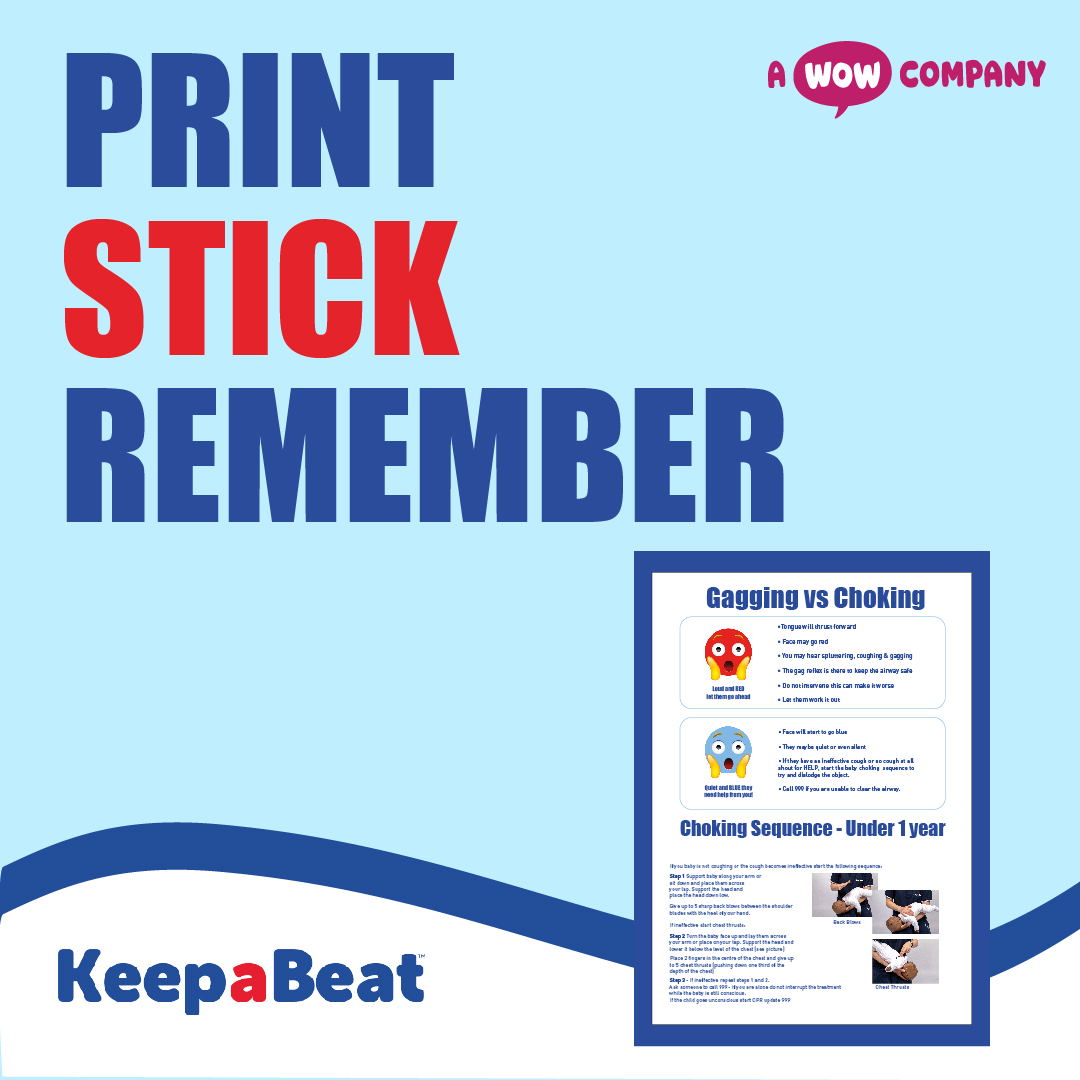Download our Gagging Vs Choking fact file here (under 1 year)
This article is aimed at parents and carers that are apprehensive about choking when introducing baby to solid food.

How common is choking?
Unfortunately on average one child dies every month in the UK and hundreds more are hospitalised.
It is therefore imperative that you feel prepared…
Lets talk weaning:
It’s pretty incredible if you think about it. Babies have to learn to move the food around, chew, move it to the back of the mouth, swallow and breath all in pretty quick succession. The anatomy of a baby’s mouth is slightly different to ours. The gag reflex is more sensitive and is acting like a gate keeper, making sure that only air is allowed in to the airway. But, it takes some training and getting use to. Like anything else, babies grow, learn and develop at different rates. So some babies will naturally gag more than others. Doesn’t do your nerves any good though does it?
When you start your weaning journey it’s important that you know the difference between gagging and choking.
Gagging is a completely normal part of the weaning process.
As your baby grows the gag reflex moves further back in the mouth and becomes less sensitive. You should find as they get older they will gag less.
Gagging is not choking however, occasionally it may be a possible warning sign of a choking event.
Gagging is usually loud with coughing and/or spluttering.
You may notice the eyes water a little. Try to stay calm and give baby lots of encouragement.
Remember “If they’re RED let them go ahead”
DO NOT be tempted to give them any back blows yet!
Choking is when an object has either partially blocked or completely blocked the airway.
You will likely see the child’s colour changing to pale/blue, and have a weak ineffective cough or no cough at all and may be silent.
Remember: Quiet and BLUE they need help from YOU!
Hazardous foods and reducing the risk
There are foods that are known to be more hazardous than others. Those foods are listed below but generally foods that are any of the following: round, hard, have a skin on or swell when wet (e.g. marshmallows)
* Grapes, cherry tomatoes etc.
* Sausages and hotdogs
* Chunks of meat or hard cheese
* Popcorn
* Raw jelly cubes
* Nuts and seeds
* Raw vegetables and fruits (apples etc.)
* Sweets, boiled, gummy, mini eggs etc.
How to prepare foods for your baby is important!
Foods that are round (like grapes) are best prepared in a way that makes them less likely to get lodged. Cut them straight down the middle length ways and again so they are in quarters. Sausages are best cut long ways into quarters. If the skin is tough its best to remove it. Vegetables - either grate or cook so they are soft. Long and thin is best!
Nuts and seeds can be ground down - Be aware some peanut butters maybe too lumpy. Smooth is best.
Ideally try to keep meal times relaxed so that your child can concentrate on eating. Keep televisions and tablets off, the area quiet and always make sure your child is sitting down when eating. I know this can be easier said than done!
One of the best ways to prepare for a choking emergency is to do a first aid course.
We have two sessions
* First Aid For Parents and Carers - This session covers a range of topics for babies and children - More information HERE
* First Aid For Weaning - This sessions is specifically if you are weaning and covers the difference between gagging and choking, how to prepare foods, Baby choking sequence and introducing allergies - More information HERE
We have designed a printable download that has a visual gagging vs choking image and the instructions on how to deal with a choking baby.
Baby Choking sequence:
Check the mouth (do not put your fingers into the back of the airway)
Support the baby across your lap or along your arm (support their face by placing your hand around their chin)
Step 1: Give up to 5 back blows, using the heel of your hand in-between their shoulder blades
Step 2 : If ineffective turn them face up and support the head (either place on your lap or across your arm).
With two fingers in the centre of their chest do up to 5 chest thrusts at a depth of one third of the chest.
Repeat steps 1 and 2 until you clear the airway or they become unconscious. If they become unconscious call 999 and start CPR (we will cover that next week).
If you have administered a thrust you must have your baby checked over by a doctor so pop to your local hospital
FAQs
Can my baby choke on liquid?
Answer: Generally, small amounts of liquid that “go down the wrong way” are coughed out. However, a baby could choke or drown on a liquid if for example, you were to prop their bottle in front of them.
Is there more chance of choking with baby led weaning (BLW)?
Answer: There is no research to say that baby led weaning puts your child at more risk. In fact many health professionals encourage baby led weaning as it engages muscles within the mouth and gets them moving (not finished)
Can I put my fingers in to the mouth to get an object out?
Answer: Never put your fingers in to retrieve an object that is towards the back of the airway or that you can not see. You will likely push it further back.
